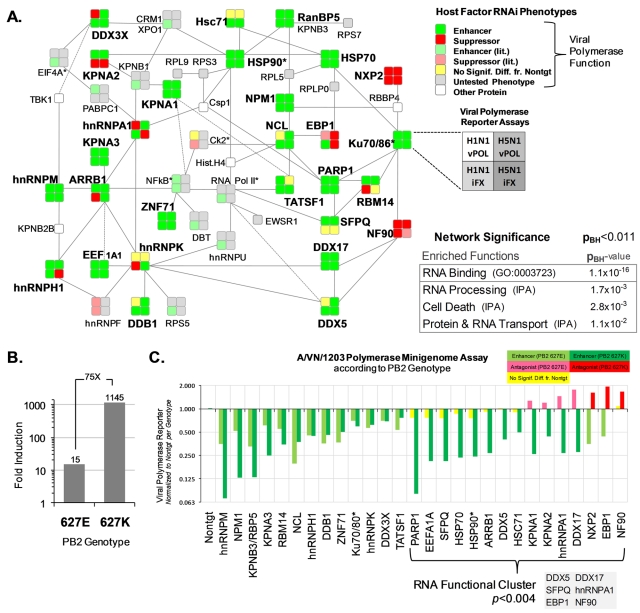FIG 2 .
Regulatory network modulating H1N1 polymerase and H5N1 polymerase according to PB2 genotype at amino acid position 627. (A) Protein interaction network comprising influenza virus polymerase-associated cellular proteins and proximal nodes extracted from the human protein interactome by Ingenuity pathways analysis (IPA), with significance estimated by Benjamini-Hochberg test (PBH). H1N1 and H5N1 polymerase-host RNAi phenotype data from VPOL-mg (vPOL) and infection-mg (iFX) assays are indicated by color according to this study and published references (lit.; Refs. 16, 22, 24–28, 30–32). Edges between nodes are reported protein-protein interactions; Untested, phenotypic assay(s) not performed for interactor; Other, connecting protein; dashed links, indirect association reliant on proteins not shown. Inset table: enriched functions found by IPA and Gene Ontology (GO) analyses. (B) Viral polymerase minigenome reporter assays with 293T cells for two A/VN/1203/04 (H5N1) viral polymerase PB2 genotypes (627K, wild type/human isolate; 627E, avianized mutant). Fold induction, ratio to results of mock VPOL-mg assay. (C) Average VPOL-mg activity for PB2 627K and 627E genotypes, expressed as a ratio to the corresponding nontarget siRNA (Nontgt) value for 28 principal network host factors. Phenotypes are classified by significance estimated by an unpaired, 2-tailed t test (enhancer or suppressor, Pmax < 0.15; no significant difference from nontarget control, Pmax ≥ 0.15). Targets are ordered by magnitude/phenotype; y axis, log2 scale. The Gene Ontology functional cluster of RNA-binding/processing proteins (P value, group enrichment score) among indicated targets exhibiting differential phenotypes is shown.

